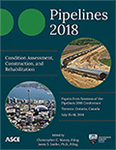Pipelines 2018
Defect Based Risk Assessment Model for Prioritizing Inspection of Sewer Pipelines
Publication: Pipelines 2018: Condition Assessment, Construction, and Rehabilitation
ABSTRACT
In presence of financial constraints and dire need for inspecting deteriorated sewer pipelines, inspection prioritization tools are required. This paper presents a defect based risk assessment model for prioritizing inspection of sewer pipelines. Different defects that could be present in sewer pipelines are used to build a deterioration model that employs dynamic Bayesian belief network from which the probability of a pipeline to be in a certain condition state with respect to age can be determined. The consequence of failure for sewer pipelines are studied from a cost benefit analysis point of view, where the costs resulting from sewer pipelines failure are studied, and the benefits from avoiding such failures are analyzed. Sugeno-fuzzy inference system is used to integrate both the probability and consequence of failure. It is expected that the resulting risk map would help key personnel in municipalities to identify sewer pipelines that require immediate interventions and would assist in better planning for inspection programs especially in cases of limited funds.
Get full access to this article
View all available purchase options and get full access to this chapter.
REFERENCES
ASCE. (2013). “2013 Grades.” Report card for America’s infrastructure, <http://www.infrastructurereportcard.org/> (December. 24, 2016).
Baik, H. S., Jeong, H. S., and Abraham, D. M. (2006). “Estimating transition probabilities in Markov chain-based deterioration models for management of wastewater systems.” J. Water. Resour. Plann. Manage., 132(1), 15–24.
Baur, R., and Herz, R. (2002). “Selective inspection planning with aging forecast for sewer types.” Water Sci. Technol., 46(6–7), 389–396.
Hahn, M. A., Palmer, R. N., Merrill, M. S., and Lukas, A. B. (2002). “Expert system for prioritizing the inspection of sewers: Knowledge base formulation and evaluation.” J. Water. Resour. Plann. Manage., 128(2), 121–129.
Halfawy, M. R., Dridi, L., and Baker, S. (2008). “Integrated decision support system for optimal renewal planning of sewer networks.” J. Comput. Civ. Eng., 22(6), 360–372.
Hintz, A. M., Barnes, D., and Millar, D. C. (2007). “Establishing a collection system baseline condition assessment program one step at a time.” Proc., Pipelines 2007: Advances and Experiences with Trenchless Pipeline Projects, ASCE, Reston, VA.
Kleiner, Y. (2001). “Scheduling inspection and renewal of large infrastructure assets.” J. Infrastruct. Syst., 7(4), 136–143.
Kleiner, Y., Rajani, B., and Sadiq, R. (2005). Risk management of large-diameter water transmission mains, AWWA Research Foundation and American Water Works Association, Denver.
Kleiner, Y., Rajani, B., and Sadiq, R. (2007). “Sewerage infrastructure: Fuzzy techniques to manage failures.” Wastewater Reuse: Risk assessment, decision making and environmental security, M. K. Zaidi, ed., Springer, The Netherlands, 241–252.
Kleiner, Y., Sadiq, R., and Rajani, B. (2004). “Modeling failure risk in buried pipes using fuzzy Markov deterioration process.” Proc., Pipeline Engineering and Construction: What’s on the Horizon?, ASCE, Reston, VA, 1–12.
Le Gat, Y. (2008). “Modeling the deterioration process of drainage pipelines.”. Urban Water J., 5(2), 97–106.
Martin, T., Johnson, D., and Anschell, S. (2007). “Using historical repair data to create customized predictive failure curves for sewer pipe risk modeling.” Proc., Leading Edge Conf. on Strategic Asset Management, International Water Association, London, UK.
McDonald, S., and Zhao, J. (2001). “Condition assessment and rehabilitation of large sewers.” Proc., Int. Conf. on Underground Infrastructure Research, Univ. of Waterloo, Waterloo, Canada, 361–369.
Prieto, L., and Sacristán, J. A. (2003). Problems and solutions in calculating quality-adjusted life years (QALYs). Health and quality of life outcomes, 1(1), 1.
Salman, B. (2010). “Infrastructure management and deterioration risk assessment of wastewater collection systems.” Ph.D. dissertation, Univ. of Cincinnati, OH.
Sinha, S. K., and McKim, R. A. (2007). “Probabilistic based integrated pipeline management system.” Tunnelling Underground Space Technol., 22(5–6), 543–552.
Sægrov, S. and Schilling, W. (2002). Computer aided rehabilitation of sewer and storm water networks. In Proc. 9 th Int. Conf. Urban Drainage–Global Solutions for Urban Drainage.
Wirahadikusumah, R., Abraham, D., and Iseley, T. (2001). “Challenging issues in modeling deterioration of combined sewers.” J. Infrastruct. Syst., 7(2), 77–84.
Information & Authors
Information
Published In
Pipelines 2018: Condition Assessment, Construction, and Rehabilitation
Pages: 1 - 9
Editors: Christopher C. Macey, AECOM and Jason S. Lueke, Ph.D., Associated Engineering
ISBN (Online): 978-0-7844-8165-3
Copyright
© 2018 American Society of Civil Engineers.
History
Published online: Jul 11, 2018
Published in print: Jul 12, 2018
Authors
Metrics & Citations
Metrics
Citations
Download citation
If you have the appropriate software installed, you can download article citation data to the citation manager of your choice. Simply select your manager software from the list below and click Download.
